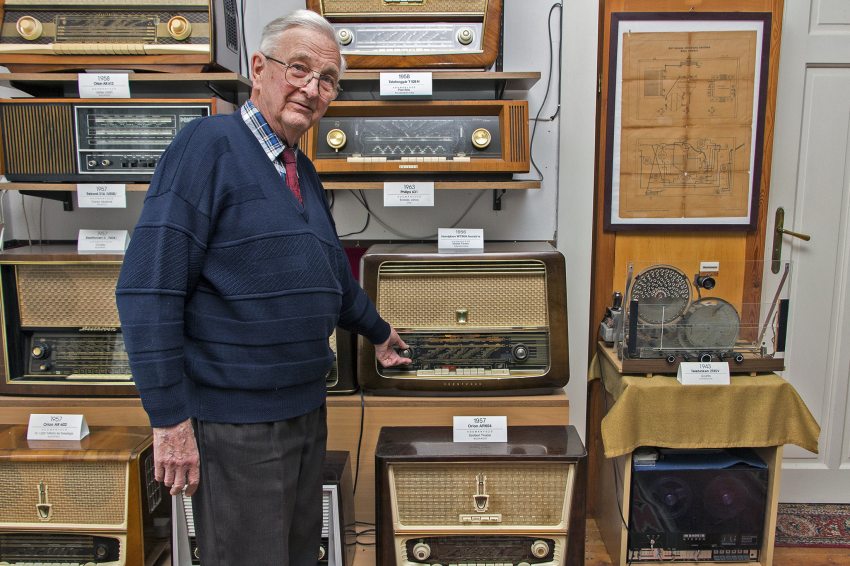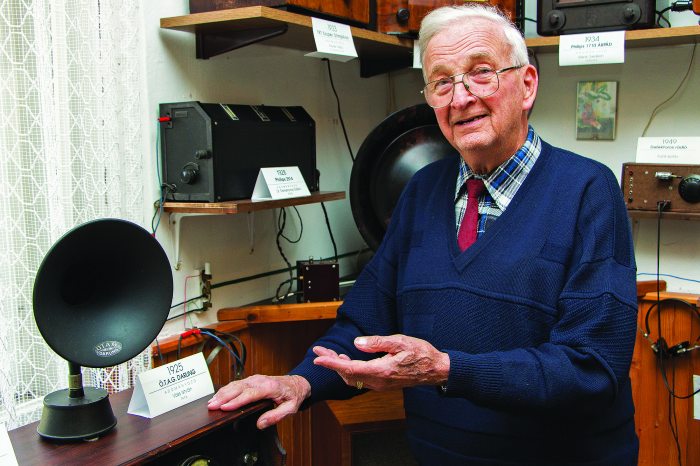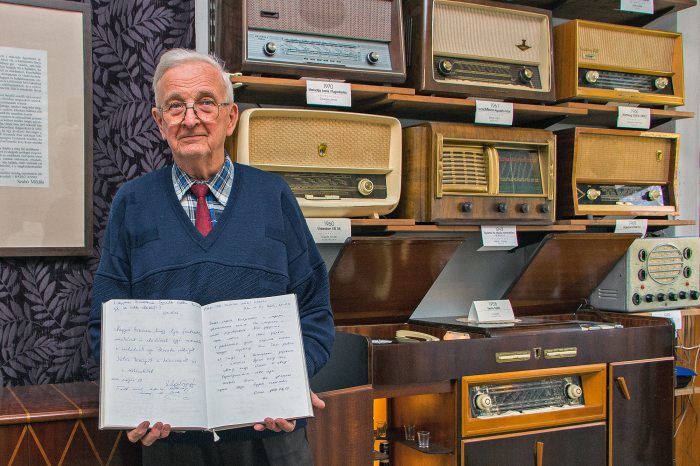"Radios are the realisation of my childhood dream" - One hundred and thirty-one historical radios in Tardos
András Tarnóczy fell in love with radios as a child and by the age of eleven had already built his own device. His passion followed him throughout his life and after retiring, he began collecting and restoring old radios. Within a few years, the collection became a museum, set up in his own home. The special feature of the ‘Tardos Radio Museum’ is that the collector accompanies each visitor around the exhibition of one the hundred and thirty-one machines, while relating the history of the radios and even turning on those requested by the guest, as all the items are in working condition.

When did your passion for radios start?
I must have been six or seven years old when I first disassembled one to see who was talking inside it. We lived on a farm where, in the absence of an electrical network, we only had a battery operated radio. Every time my parents left home, I took it apart. After a while, my parents began to notice that it would never work they returned home. I was even threatened with a report to Santa if I disassembled it again. That was a shock, but I still didn’t give up on the radio and I built my first crystal radio when I was eleven. Unfortunately, I don’t have that one any more, but I have another one, which I made two years later. It still works and is part of my collection.
As a child, did you know you wanted to work with radios?
I wanted to go to a technical university, to attend a faculty of electrical engineering but, unfortunately, the ruling order at the time did not find me suitable. Nevertheless, I found a position in the technical field, working as a surveyor in a telephone factory for six years. Then I continued to train myself and worked for twenty-seven years, until my retirement, as an equipment supervisor at the Vilati Building Electricity Installations company: in charge of the entire equipment manifest, from purchasing, through management, to repair.
How long have you been collecting radios?
I retired in 1991 and we moved to Rábapatona. Word spread fast that I am familiar with radios, and more and more people asked me to repair their old devices. After someone brought me their sixth radio, I asked them why they need so many and if they collected them. It turned out that they took them to Austria and Germany to sell, where they are in high demand. The next time he came, he gave me a couple as a gift, I repaired them and from then on I started collecting.
When we moved to Tardos in 1998, I already had twenty-one radios.
In 2001, I was asked to host a two-week exhibition at the cultural centre. There was a lot of interest, so everyone encouraged me to make the collection a permanent exhibition. The municipality supported the initiative financially. I bought shelves and, in the same year, the museum opened in my home with twenty-seven radios.
How many items does your collection contain now?
I have one hundred and thirty-one. I restored them all myself. Over a period of twenty-six years, I have spent more than five thousand hours making them operational again. I’m never just content with the devices only functioning again, I like to restore them from the outside as well. I will not exhibit any piece until it is in its original state. I once had to wait for three years for the right upholstery, which was acquired from Tanzania by one of my fellow collectors.
How do you feel when an old radio sounds again after hours of work?
It gives me enormous pleasure. The restoration time varies, depending on the condition of the device and the number of problems, but I never give up. The amazing thing is that every device has a different problem, the same issue is very rarely repeated. To find it, I usually set up a logical sequence of examination.
Repair also requires serious mental work, which helps keep me stay mentally agile.
Where do you get the parts needed for the restoration?
I also collect the parts. I’ve amassed a lot over the decades and there will still be plenty left over after I am gone. If I don’t have the right parts, which sometimes happens, I turn to my fellow collectors for help, I have a lot of contacts, not only in Hungary but also in France, Germany, Austria, the Netherlands and Slovakia.
Do you also restore the housings yourself?
I can do smaller tasks myself, my dear friend, a retired carpenter, taught me some tricks of the trade, such as placing the grain of the veneer sheet covering the device perpendicular to that of the plywood of the case because, when drying, the veneer would crack in the direction of its grain but the perpendicular grain of the plywood stops it. For larger jobs, I turn to a carpenter. I don’t understand varnishing at all.
Where are your radios from? Do you buy them, or receive them as gifts?
My collection increases mostly through donations. On each exhibit, I indicate the name of the donor, along with the type, manufacturer and year of manufacture of the radio. I have been a member of the Nostalgia Radio Association for more than twenty years and we meet quarterly at the ‘Puskás Tivadar Technical School of Telecommunications’, where we swap and buy from each other. Real treasures can be found there.
Do you collect all kinds or do you specialise in a certain type or era?
I mainly collect Hungarian radios, demonstrating the history of Hungarian radio production from the beginning, though some foreign pieces can also be found in the collection. I have Italian, French, Austrian, German and Russian devices as well. From the very beginning, I decided to focus on the initial period, collecting models manufactured up until the end of valve radio production, that is, until the mid-1970s, because a significant portion of my spare parts are also for those. I no longer collect devices with transistor or integrated circuits.
Which is your oldest radio?
The oldest ones are ninety-three or ninety-four years old. Those are called box radios, because the machine itself is a box.
In those days they did not have built-in speakers, but placed them on top or next to the device. Collectors also call some speakers a basin speaker because they are similar to them in size and shape. I also have some interesting pieces from the period between the two world wars. Initially, the Telefongyár Részvénytársaság, the Orion Factory and EKA made radios, of which I have several in my collection. It is worth knowing that initially in Hungary, four Western companies, Standard, Philips, Telefunken and Siemens, also built factories to save on shipping costs. Those factories were nationalised in 1949, and none of those companies have re-established a factory in Hungary since then.
Which pieces are you most proud of?
One is a 1941 Orion 177 AG, which is also a decorative object. It is a real rarity and there are only a few of them in Hungary. The others did not survive the Second World War. I even have its original invoice and letter of guarantee. The other, also a 1941 piece, was made in a Czech factory that was in operation for barely six years, probably due to a bombing or its conversion to a munitions factory. I also have a ‘Pacsirta’, which is one of the longest-produced devices, brought out by Orion in 1958, two years after which Comecon took production from them. However, the ‘Pacsirta’ was still such a sought-after model that Videoton took over the entire manufacturing technology and continued to produce it until 1966. I’m actually attached to each device as I worked on them for many hours.
The Austrian, Horniphon W796A radio, which has several special technical features and sounds like a HiFi system, has the most amazing sound quality.
The ancestor of the hi-fi stack can also be found in the museum. What do we need to know about it?
It is a radio combined with a Tetra 528K turntable and tape recorder, which also contains a liquor cabinet. It was manufactured by Telefongyár Rt. in 1958. Only a limited number were made, but it was not intended for the average civilian home as its price was equivalent to the six-month salary of a trained worker. It was seen mainly in ministries, county council offices and military headquarters.
Do they still contact you to repair an old piece?
Yes, I have many people contact me from abroad. It is all the rage to have old radios as antique furniture. They brought me one today and I'm trying to get it to sound again. I also have some pieces that I restored and kept which didn’t become part of my collection. If someone comes to buy them, then I will sell them.
If you were approached by an interested party, would you sell the entire collection?
I have been approached already, but the purchase fell through because they wanted to cherry pick certain radios from the collection. I told them they could buy all of them, or none. Then there was a buyer to whom I said yes: the Kuny Domokos Museum bought the entire collection four years ago. The offer came at just the right time, as I am 85 years old and I have been preoccupied with the thought of what will happen to the radios after I am gone. We signed the sale and purchase agreement four years ago, which included a clause that the exhibition would remain here in my home, in Tardos, for the rest of my life and that, as long as I was able, I would welcome visitors. If I can’t cope any more, I will let them know and they will take the exhibition away. It is reassuring and gratifying to know that the radios, which were the realisation of my childhood dream, will go to a good place.
I looked for the talking man inside them and I found him. It’s a wonderful thing to be able, through them, to hear a person on the other side of the world.
It makes me very happy to share my passion with others. I have already had visitors from more than fifteen countries and I also have a guestbook with beautiful entries in different languages. The most beautiful entry was written in Cyrillic letters by a Russian lady, who actually got very emotional when I played her a Dunayevsky composition. Because I’ve been alone for three years, visitors are my connection to the outside world, so I welcome them while I am able.








